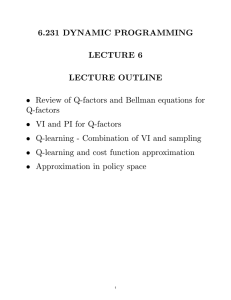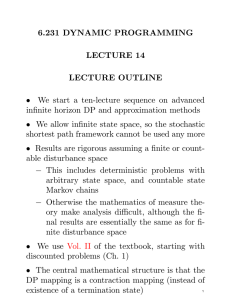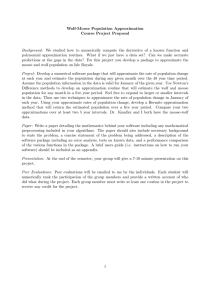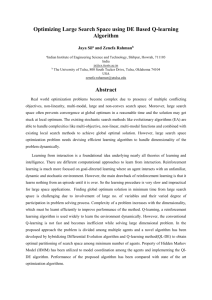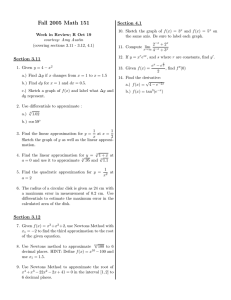Document 13342354
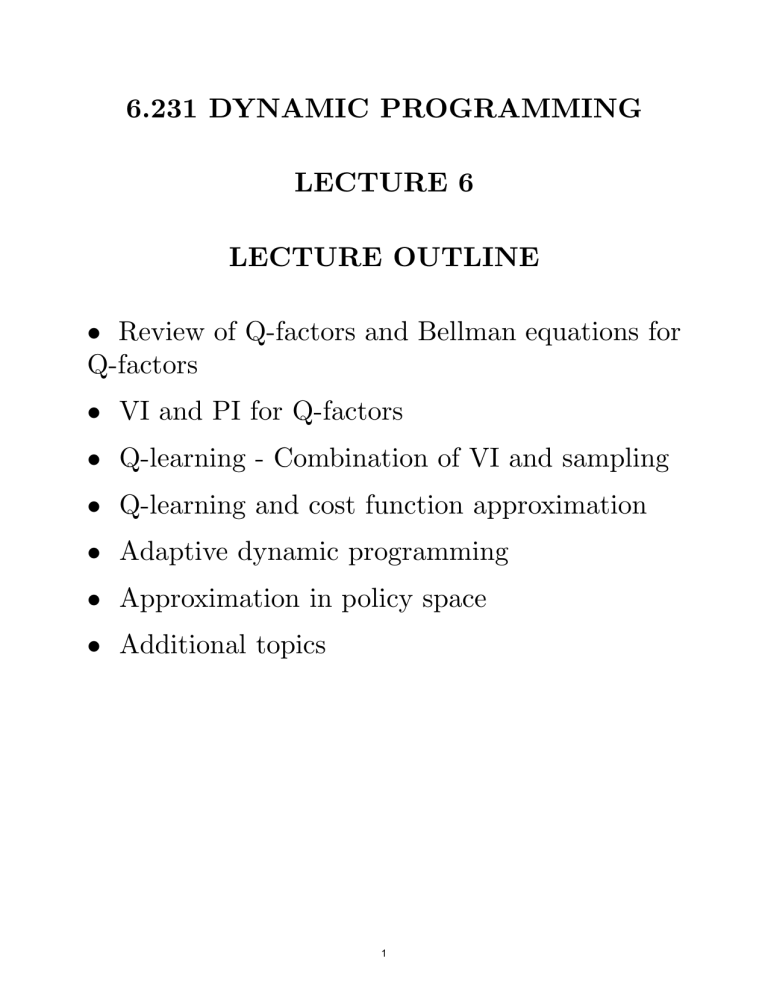
6.231
DYNAMIC PROGRAMMING
LECTURE 6
LECTURE OUTLINE
• Review of Q-factors and Bellman equations for
Q-factors
• VI and PI for Q-factors
• Q-learning - Combination of VI and sampling
• Q-learning and cost function approximation
• Adaptive dynamic programming
• Approximation in policy space
• Additional topics
1
REVIEW
2
DISCOUNTED MDP
• System: Controlled Markov chain with states i = 1 , . . . , n and finite set of controls u ∈ U ( i )
• Transition probabilities: p ij
( u ) pii ( u ) i i pij ( u ) pji ( u ) j j p jj
( u )
• Cost of a policy π = { µ
0
, µ
1
, . . .
} starting at state i :
J
π
( i ) = lim E
N →∞
N
( ) α k g i k
, µ k
( i k
) , i k +1
| i = i
0 k =0 with α ∈ [0 , 1)
• Shorthand notation for DP mappings n
( T J )( i ) = min u ∈ U ( i ) j =1
( ) p ij
( u ) g ( i, u, j )+ αJ ( j ) , i = 1 , . . . , n, n
( )( ( ) )
( T
µ
J )( i ) = p ij
µ ( i ) g i, µ ( i ) , j + αJ ( j ) , i = 1 , . . . , n j =1
3
BELLMAN EQUATIONS FOR Q -FACTORS
• The optimal Q -factors are defined by n
X
( ) Q ∗ ( i, u ) = p ij
( u ) g ( i, u, j ) + αJ ∗ ( j ) , ∀ ( i, u ) j =1
• Since J ∗ = T J ∗ , we have J ∗ ( i ) = min u ∈ U ( i )
Q ∗ ( i, u ) so the optimal Q -factors solve the equation n
�
X
Q ∗ ( i, u ) = p ij
( u ) g ( i, u, j ) + α min Q ∗ ( j, u ′ ) u ′ ∈ U ( j ) j =1
�
• Equivalently Q ∗ = F Q ∗ , where n
�
X
( F Q )( i, u ) = p ij
( u ) g ( i, u, j ) + α min Q ( j, u ′ ) u ′ ∈ U ( j ) j =1
�
• This is Bellman’s Eq. for a system whose states are the pairs ( i, u )
• Similar mapping F
µ and Bellman equation for a policy µ : Q
µ
= F
µ
Q
µ
4
BELLMAN EQ FOR Q -FACTORS OF A POLICY
StateControl Pairs: Fixed Policy
µ j ) � j, µ ( j ) � ( i, u ) g ( i, u, j ) p ij
( u )
) States j p
µ ( j )
States
• Q-factors of a policy µ : For all ( i, u ) n
X
( ( Q
µ
( i, u ) = p ij
( u ) g ( i, u, j ) + αQ
µ j, µ ( j ) )) j =1
Equivalently Q
µ
= F
µ
Q
µ
, where n
X
( ( ( F
µ
Q )( i, u ) = p ij
( u ) g ( i, u, j ) + αQ j, µ ( j ) )) j =1
• This is a linear equation. It can be used for policy evaluation.
• Generally VI and PI can be carried out in terms of Q-factors .
• When done exactly they produce results that are mathematically equivalent to cost-based VI and PI.
5
WHAT IS GOOD AND BAD ABOUT Q-FACTORS
• All the exact theory and algorithms for costs applies to Q-factors
− Bellman’s equations, contractions, optimal ity conditions, convergence of VI and PI
• All the approximate theory and algorithms for costs applies to Q-factors
− Projected equations, sampling and exploration issues, oscillations, aggregation
• A MODEL-FREE (on-line) controller imple mentation
− Once we calculate Q ∗ ( i, u ) for all ( i, u ),
µ ∗ ( i ) = arg min Q ∗ ( i, u ) , u ∈ U ( i )
∀ i
− Similarly, once we calculate a parametric ap proximation Q i, u ; r ) for all ( i, u ),
µ i ) = arg min
˜
( i, u ; r ) , u ∈ U ( i )
∀ i
• The main bad thing: Greater dimension and more storage! (It can be used for large-scale prob lems only through aggregation, or other approxi mation.)
6
Q-LEARNING
7
Q-LEARNING
• In addition to the approximate PI methods adapted for Q-factors, there is an important addi tional algorithm:
− Q-learning , a sampled form of VI (a stochas tic iterative algorithm).
• Q-learning algorithm (in its classical form):
− Sampling: Select sequence of pairs ( i k
, u k
)
[use any probabilistic mechanism for this, but all ( i, u ) are chosen infinitely often].
− Iteration: For each k , select j k according to p i k j
( u k
). Update just Q ( i k
, u k
):
Q k +1
( i k
,u k
) = (1 − γ k
) Q k
( i k
, u k
)
�
+ γ k g ( i k
, u k
, j k
) + α min Q k
( j k
, u ′ ) u ′ ∈ U ( j k
)
�
Leave unchanged all other Q-factors.
− Stepsize conditions: γ k
↓ 0
• We move Q ( i, u ) in the direction of a sample of n
�
X
( F Q )( i, u ) = p ij
( u ) g ( i, u, j ) + α min Q ( j, u
′ u ′
∈ U ( j )
) j =1
8
�
NOTES AND QUESTIONS ABOUT Q-LEARNING
Q k +1
( i k
,u k
) = (1 − γ k
) Q k
( i k
, u k
)
+ γ k g ( i k
, u k
, j k
) + α min Q k
( j k
, u ′ ) u ′ ∈ U ( j k
)
• Model free implementation. We just need a simulator that given ( i, u ) produces next state j and cost g ( i, u, j )
• Operates on only one state-control pair at a time. Convenient for simulation, no restrictions on sampling method. (Connection with asynchronous algorithms.)
• Aims to find the (exactly) optimal Q-factors.
• Why does it converge to Q ∗ ?
• Why can’t I use a similar algorithm for optimal costs (a sampled version of VI)?
• Important mathematical (fine) point: In the Q factor version of Bellman’s equation the order of expectation and minimization is reversed relative to the cost version of Bellman’s equation: n
J ∗ ( i ) = min u ∈ U ( i )
X j =1
( p ij
( u ) g ( i, u, j ) + αJ ∗ ( j ) )
9
CONVERGENCE ASPECTS OF Q-LEARNING
• Q -learning can be shown to converge to true/exact
Q -factors (under mild assumptions).
• The proof is sophisticated, based on theories of stochastic approximation and asynchronous algo rithms .
• Uses the fact that the Q-learning map F :
�
( F Q )( i, u ) = E j g ( i, u, j ) + α min Q ( j, u ′ ) u ′
� is a sup-norm contraction.
• Generic stochastic approximation algorithm:
− Consider generic fixed point problem involv ing an expectation:
{ x = E w f ( x, w ) }
{ } − Assume E w f ( x, w ) is a contraction with respect to some norm, so the iteration x k +1
{ = E w f ( x k
, w ) } converges to the unique fixed point
{ } − Approximate E w f ( x, w ) by sampling
10
STOCH.
APPROX.
CONVERGENCE IDEAS
• Generate a sequence of samples { w
1
, w
2
, . . .
} , and approximate the convergent fixed point iter
{ ation x k +1
= E w f ( x k
, w ) }
• At each iteration k use the approximation x k +1
=
1 k k
X
{ f ( x k
, w t
) ≈ E w f ( x k
, w ) } t =1
• A major flaw: it requires, for each k , the compu tation of f ( x k
, w t
) for all values w t
, t = 1 , . . . , k .
• This motivates the more convenient iteration x k +1
=
1 k k
X f ( x t
, w t
) , k = 1 , 2 , . . . , t =1 that is similar, but requires much less computa tion; it needs only one value of f per sample w t
.
• By denoting γ k
= 1 /k , it can also be written as x k +1
= (1 − γ k
) x k
+ γ k f ( x k
, w k
) , k = 1 , 2 , . . .
• Compare with Q-learning, where the fixed point problem is Q = F Q
{ ( F Q )( i, u ) = E j g ( i, u, j ) + α min Q ( j, u ′ ) } u ′
11
Q -LEARNING COMBINED WITH OPTIMISTIC PI
• Each Q-learning iteration requires minimization over all controls u ′ ∈ U ( j k
):
Q k +1
( i k
,u k
) = (1 − γ k
) Q k
( i k
, u k
)
+ γ k g ( i k
, u k
, j k
) + α min Q k u ′ ∈ U ( j k
)
( j k
, u ′ )
• To reduce this overhead we may consider re placing the minimization by a simpler operation using just the “current policy” µ k
• This suggests an asynchronous sampled version of the optimistic PI algorithm which policy eval uates by
Q k +1
= F m k
µ k
Q k
, and policy improves by µ k +1
( i )
∈ arg min u ∈ U ( i )
Q k +1
( i, u )
• This turns out not to work (counterexamples by Williams and Baird, which date to 1993), but a simple modification of the algorithm is valid
• See a series of papers starting with
D. Bertsekas and H. Yu, “Q-Learning and En hanced Policy Iteration in Discounted Dynamic
Programming,” Math. of OR, Vol. 37, 2012, pp.
66-94 12
Q -FACTOR APPROXIMATIONS
• We introduce basis function approximation:
˜
( i, u ; r ) = φ ( i, u ) ′ r
• We can use approximate policy iteration and
LSTD/LSPE for policy evaluation
• Optimistic policy iteration methods are fre quently used on a heuristic basis
• An extreme example: Generate trajectory { ( i k
, u k
) | k = 0 , 1 , . . .
} as follows.
• At iteration k , given r k and state/control ( i k
, u k
):
(1) Simulate next transition ( i k
, i k +1
) using the transition probabilities p i k j
( u k
).
(2) Generate control u k +1 from u k +1
= arg min
˜
( i k +1
, u, r k
) u ∈ U ( i k +1
)
(3) Update the parameter vector via r k +1
= r k
− (LSPE or TD-like correction)
• Complex behavior, unclear validity (oscilla tions, etc). There is solid basis for an important special case: optimal stopping (see text)
13
BELLMAN EQUATION ERROR APPROACH
• Another model-free approach for approximate evaluation of policy µ : Approximate Q
µ
( i, u ) with
Q
µ
( i, u ; r
µ
) = φ ( i, u ) ′ r
µ
, obtained from r
µ
∈ arg min Φ r − F
µ
(Φ r )
2 r
ξ where I · I
ξ is Euclidean norm, weighted with re spect to some distribution ξ .
• Implementation for deterministic problems:
(1) Generate a large set of sample pairs ( i k
, u k
) , and corresponding deterministic costs g ( i k
, u k
)
( and transitions j k
, µ ( j k
) ) (a simulator may be used for this).
(2) Solve the linear least squares problem :
X min r
( i k
,u k
)
( ( )
′
φ ( i k
, u k
) ′ r − g ( i k
, u k
) + αφ j k
, µ ( j k
) r )
2
• For stochastic problems a similar (more com plex) least squares approach works. It is closely related to LSTD (but less attractive; see the text).
• Because this approach is model-free, it is often used as the basis for adaptive control of systems with unknown dynamics .
14
ADAPTIVE CONTROL BASED ON ADP
15
LINEAR-QUADRATIC PROBLEM
• System : x k +1
= Ax k
+ Bu k
, x k
∈ ℜ n , u k
∈ ℜ m
• Cost : �
∞ k =0
( ′ k k
+ u Ru k
), Q ≥ 0, R > 0
• Optimal policy is linear : µ ∗ ( x ) = Lx
• The Q-factor of each linear policy µ is quadratic :
Q
µ
( x, u ) = ( x ′ u ′ ) K
µ
� � x u
( ∗ )
• We will consider A and B unknown
• We represent Q-factors using as basis func tions all the quadratic functions involving state and control components x i x j , u i u j , x i u j , ∀ i, j
These are the “rows” φ ( x, u ) ′ of Φ
• The Q-factor Q
µ of a linear policy µ can be ex actly represented within the approximation subspace:
Q
µ
( x, u ) = φ ( x, u ) ′ r
µ where r
µ consists of the components of K
µ in (*)
16
PI FOR LINEAR-QUADRATIC PROBLEM
• Policy evaluation : r
µ is found by the Bellman error approach
X min r
( x k
,u k
)
φ ( x k
, u k
) ′ ( r
− x
′ k
Qx k
+ u
′ k
( )
′
)
Ru k
+ φ x k +1
, µ ( x k +1
) r
2 where ( x k
, u k
, x k +1
) are many samples generated by the system or a simulator of the system.
• Policy improvement :
( µ ( x ) ∈ arg min φ ( x, u ) ′ r
µ u
)
• Knowledge of A and B is not required
• If the policy evaluation is done exactly, this becomes exact PI, and convergence to an optimal policy can be shown
• The basic idea of this example has been gener alized and forms the starting point of the field of adaptive dynamic programming
• This field deals with adaptive control of continuousspace, (possibly nonlinear) dynamic systems, in both discrete and continuous time
17
APPROXIMATION IN POLICY SPACE
18
APPROXIMATION IN POLICY SPACE
• We parametrize policies by a vector r = ( r
1
, . . . , r s
)
(an approximation architecture for policies).
• µ ( r ) = { µ i ; r ) | i = 1 , . . . , n } defines a cost vector J
µ r )
( a function of r ).
• We optimize some measure of J
µ r ) over r .
• For example, use a random search, gradient, or other method to minimize over r n
X
ξ i
J
µ r )
( i ) , i =1 where ξ
1
, . . . , ξ n are some state-dependent weights.
• An important special case: Introduce cost ap proximation architecture V ( i ; r ) that defines indi rectly the parametrization of the policies n
µ i ; r ) = arg min u ∈ U ( i )
X j =1
( ) p ij
( u ) g ( i, u, j )+ αV ( j ; r ) , ∀ i
• This introduces state features into approxima tion in policy space.
• A policy approximator is called an actor , while a cost approximator is also called a critic . An actor and a critic may coexist.
19
APPROXIMATION IN POLICY SPACE METHODS
• Random search methods are straightforward and have scored some impressive successes with challenging problems (e.g., tetris).
− At a given point/ r they generate a random collection of neighboring r . They search within the neighborhood for better points.
− Many variations (the cross entropy method is one).
− They are very broadly applicable (to discrete and continuous search spaces).
− They are idiosynchratic.
• Gradient-type methods (known as policy gra dient methods ) also have been used extensively.
− They move along the gradient with respect to r of n
X
ξ i
J
µ r )
( i ) i =1
− There are explicit gradient formulas which can be approximated by simulation.
− Policy gradient methods generally suffer by slow convergence, local minima, and exces sive simulation noise.
20
COMBINATION WITH APPROXIMATE PI
• Another possibility is to try to implement PI within the class of parametrized policies .
• Given a policy/actor µ ( i ; r k
), we evaluate it
(perhaps approximately) with a critic that pro duces J
˜
µ
, using some policy evaluation method.
• We then consider the policy improvement phase n
( µ ( i ) ∈ arg min p ij
( u ) g ( i, u, j ) + αJ u
X j =1
˜
µ
) ( j ) , ∀ i and do it approximately via parametric optimiza tion n n
�
( ) ( ) min ξ i p ij
µ ( i ; r ) g i, µ ( i ; r ) , j + αJ r
X X i =1 j =1
˜
µ
( j )
� where ξ i are some weights.
• This can be attempted by a gradient-type method in the space of the parameter vector r .
• Schemes like this been extensively applied to continuous-space deterministic problems.
• Many unresolved theoretical issues, particularly for stochastic problems.
21
FINAL WORDS
22
TOPICS THAT WE HAVE NOT COVERED
• Extensions to discounted semi-Markov, stochas tic shortest path problems, average cost problems, sequential games ...
• Extensions to continuous-space problems
• Extensions to continuous-time problems
• Adaptive DP - Continuous-time deterministic optimal control. Approximation of cost function derivatives or cost function differences
• Random search methods for approximate policy evaluation or approximation in policy space
• Basis function adaptation (automatic genera tion of basis functions, optimal selection of basis functions within a parametric class)
• Simulation-based methods for general linear problems, i.e., solution of linear equations, linear least squares, etc - Monte-Carlo linear algebra
23
CONCLUDING REMARKS
• There is no clear winner among ADP methods
• There is interesting theory in all types of meth ods (which, however, does not provide ironclad performance guarantees)
• There are major flaws in all methods:
− Oscillations and exploration issues in approx imate PI with projected equations
− Restrictions on the approximation architec ture in approximate PI with aggregation
− Flakiness of optimization in policy space ap proximation
• Yet these methods have impressive successes to show with enormously complex problems, for which there is often no alternative methodology
• There are also other competing ADP methods
(rollout is simple, often successful, and generally reliable; approximate LP is worth considering)
• Theoretical understanding is important and nontrivial
• Practice is an art and a challenge to our cre ativity!
24
THANK YOU
25
MIT OpenCourseWare http://ocw.mit.edu
6.231
Dynamic Programming and Stochastic Control
Fall 20 1 5
For information about citing these materials or our Terms of Use, visit: http://ocw.mit.edu/terms .
